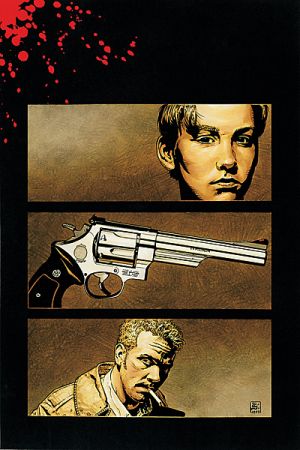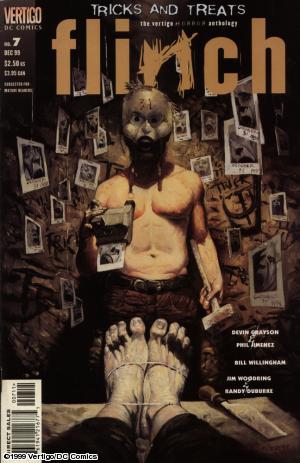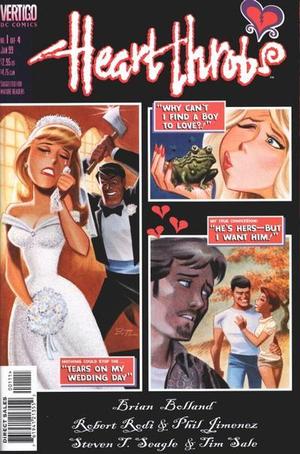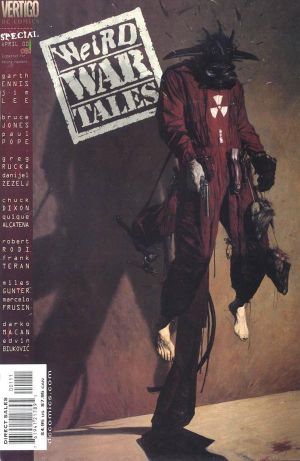- Comics
- Comics Reviews
- Manga
- Comics Reviews
- European Comics
- News
- Comics News
- Press Releases
- Columns
- Spotlight
- Digital Comics
- Webcomics
- Cult Favorite
- Back Issues
- Webcomics
- Movies
- Toys
- Store
- More
- About
By Andy Frisk
November 5, 2010 - 23:15
“Shoot” the once controversial Hellblazer tale penned by Warren Ellis that was supposed to appear in Hellblazer #141, and deals with school yard shootings, finally gets properly published in a Vertigo title. It’s actually quite a tame story by today’s standards. Ten years ago though, around the time of the Columbine shootings, stories such as this were considered too controversial to print and instead were swept under the rug. The world has changed considerably in the last decade, and now such topics are not nearly as taboo. “Shoot” though is only one of the several stories published in Vertigo Resurrected #1 that are intelligent looks at society and the human condition. The idea behind this new series is rather obvious when one considers the title. The series will “resurrect” various titles and tales from the now substantial DC Comics Vertigo catalogue. This first issue highlights tales from short lived Vertigo series such as Heartthrobs, Strange Adventures, Weird War Tales, and Flinch. Most of these titles were published in what I often refer to as the dead zone of the late 1990s and early 2000s, not just because I was out of reading and collecting comics then, but because the industry was going through a major contraction after the speculation boom of the late 1980s and early 1990s. Many collectors and readers left the major publishers in droves during this time. Unfortunately, we missed some pretty good books that were published then. With Vertigo Resurrected #1, readers such as myself are treated to a peak into this time of non-collecting and reading, at least where DC Comics’ Vertigo line is concerned. Being a huge Vertigo fan, I’m looking forward to seeing exactly what is going to get published under the title Vertigo Resurrected. The second issue will focus on the short run miniseries by Peter Milligan and Ted McKeever titled The Extremist. I actually collected this series as it was published closer to the early 1990s, so I might skip this one, but subsequent issues will definitely pique my interest. The first one certainly has.
 |
The tales, and the titles they are taken from, were uniquely and intelligently picked for inclusion in this first issue. They represent more the type of thematic tone many Vertigo titles take as opposed to representing Vertigo’s most popular or recognizable characters. The only real recognizable character in all of the stories is John Constantine, and he isn’t even in Ellis’ tale all that much. It would have been easy, and perhaps more profitable, to load the first issue of Vertigo Resurrected with early Sandman, Swamp Thing, or other seminal Vertigo title issues. Granted, these tales are readily available in several trade paperback collections, but are always prime material for republication. By selecting tales for inclusion that have been less popular or widely distributed, the focus is to present the type of story that Vertigo has become know for rather than the type of characters Vertigo has popularized.
 |
Some of the tales that are standouts in this collection are Seagle and Sale’s “Diagnosis” that puts a new spin on the romantic melodramas of the 1950s where a successful surgeon who specializes in breast cancer and tumor removal becomes unnaturally obsessed with the health of his fiancé’s breasts; Bill Willingham’s “It Takes a Village” that foreshadows his brilliant work on Fables, and Milligan and Risso’s “The Death of a Romantic” that explores the needy nature of a hopeless romantic and how through a unique relationship with a long dead romantic poet she learns to have the strength to walk away (the tale doesn’t even have a hint of the supernatural about it—very interesting considering the nature of the relationship—it’s a pretty masterful tale and exactly what we’d expect from Milligan). These tales address various mature (as in thoughtful) and controversial themes as opposed to the average superhero comic book fare.
Granted, several mainstream superhero books have gotten much more intelligent and mature lately (namely Superman), but where Vertigo is concerned, one is virtually assured to be intellectually stimulated and emotionally stirred more often than not. For example, in “It Takes a Village” the very real and relevant theme of promoting a climate of fear in a society by manufacturing it in order to keep the “old values” alive is brilliantly explored by Willingham. The village’s mayor uses the fear of an outside threat to the society because “nothing strengthens the old values, (and) keeps our community together with God in our hearts, like a regular need to break out the torches and pitchforks and go on an old-fashioned monster hunt.” Willingham brilliantly uses the metaphor of monsters (werewolves and vampires—metaphors for The Other) to manipulate the community into staying true to the “old values.” This theme is incredibly relevant to today’s political climate where fear is what seems to drive people to the polls in order to vote against the “death panels” and apparent socialism that some see as the monsters (more aptly the manufactured monsters) of modern times. Using fear to keep the “old values” alive and cause people to not even listen to progressive ideas or at debate them logically is an exercise in the propagation of an appeal to emotion over reason (a major logical fallacy and a dangerous one when propagated on a large scale). Appeals to emotion that are bolstered by fear mongering are some of the most dangerous and deadly types of political machination. We only have to look back to the horrors 70 years or so to see what happens when fear and fear mongers rule a society.
 |
Don’t get the idea though that all of these stories, or that the majority of Vertigo titles, are inherently politically themed in nature. They are not. Tales like the aforementioned “Shoot” are societal in nature. It’s a tale about how the legacy of broken homes, an underperforming economy, and parents that are too preoccupied with themselves is already beginning to affect children. “Resolve” by Bruce Jones is a tale that harkens back to the classic and metaphoric gothic horrors of the Romantic Age like Shelly’s Frankenstein (a type of intelligent gothic horror that has recently been revived with works like Let Me In) where the villainess is forced to battle with the darkness in herself and her lack of resolve to win the fight. Brian Azzarello’s “Native Tongue” explores the evil that is inherent in humanity that we often fail to acknowledge instead wishfully blaming it on supernatural or extraterrestrial fantasy.
The artists who work is showcased in this selection of tales are as renowned for their work as the showcased writers are. Sequential art heavyweights like Tim Sale (Batman The Long Halloween) Jim Lee (X-Men, Superman), Frank Quitely (All-Star Superman), Tim Bradstreet (The Punisher, Hellblazer), and Bill Willingham (Fables), who does double duty as writer and artist. These, and all the artists whose work is collected herein, are masters of their craft and had already had long and productive artistic careers before working on the projects collected in Vertigo Resurrected #1 or have subsequently gone on to have long and productive artistic careers since.
 |
It is storytelling like this that makes DC Comics’ Vertigo line, which prides itself on presenting these types of intelligent and provocative themes, one of the best sequential art publishers. Vertigo Resurrected #1 is a title definitely worth checking out, especially if you’re tired of the normal superhero tale and want to see what a mainstream publisher has to offer beyond the world of spandex drenched affairs. You won’t be disappointed.
Rating: 10 /10